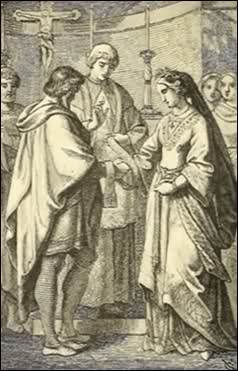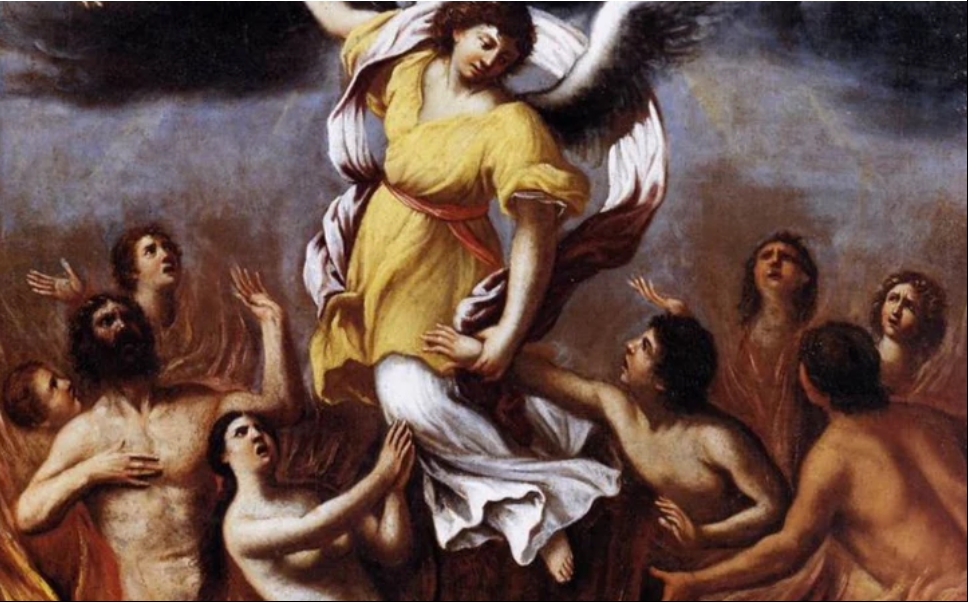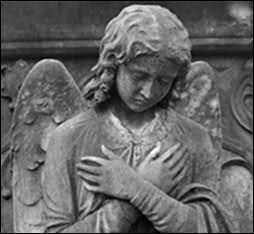The Immaculate Conception – A Lily Among Thorns
As the lily among thorns, so is my love among the daughters. (Sg:2:2:)
How mighty are God’s works! The word went forth that the human race should be redeemed by the Son of God made man. He was to come unto His own, and His own were to be made ready for His coming. And great was the preparation: the whole world was in peace; the whole Roman world was enrolled, Mary was conceived Immaculate. And this last was the greatest wonder of all!
Adam’s sin betrayed as it were the whole human race to Satan. It handed over to him the vast dominion of this world. Every child of Adam came under Satan’s ban. So much his was every soul, that to belong again to God it had to be repurchased at an infinite price.
Every child but one — Mary, daughter of Joachim and Anna: Mary who was to be Mother of God. She was, through the merits of her Son, without stain from the first moment of her existence. God by a meek maid conquered the rebellious spirit who thought to be as the Most High, and crushed with Mary’s heel the serpent’s head. She was the sole triumph of the four thousand years before her birth and of the two thousand years that followed. Never again shall we see an Immaculate One upon the earth.
If we could only understand what sin is, how we should rejoice in our Lady’s Immaculate Conception. Immaculate, without stain, or spot, or blemish. We are so dull and have grown so callous to sin and its horrors that we almost take it as a matter of course. But indeed sin is not a matter of course, even for the weakest of us. It is one of the devil’s lies to make men believe that sinning is necessary, unavoidable, a part of the present system. Sin is terrible, horrible; disfiguring the soul in this world and torturing it in the next. It is the whole evil of the world, the source of all suffering and misery. And it can be resisted, can be overcome. As a powerful engine makes its way over a rough sea and against a strong wind, so can our will, fortified with grace, overcome the world, the devil, and the flesh. That there are shipwrecks, partial or total, and millions of them, does not take away the possibility of a safe transit.
But why talk of sin today, of all days in the year, when we are celebrating Mary’s spotlessness? Let us rather turn our weary eyes away from that evil to which we are akin and lift them up to rest on Mary. And it is a rest. If there were a spot on earth where we could truly say, “Here no sorrow can come!” how would people flock to that spot.
But there is no such place. Still there is Mary! Hers is a soul where perfect peace and holy joy dwell undisturbed. She was foreshadowed in the Old Testament under the most beautiful types: the dove that could find no spot clean enough for a resting-place; the many-colored rainbow, reaching from heaven to earth and ratifying God’s promise to man; the fiery bush, burning but unconsumed; the majestic cloud of flame that led the Israelites into the Promised Land; Aaron’s rod with its pure white blossom; the Ark of the Covenant, God’s home on earth; Gideon’s fleece, exempt from the common lot; “the garden enclosed” of the Canticle — these and many more were faint symbols of Mary’s soul.
And this beautiful one, God’s Mother, is my Mother too, given to me to be my own. What shall I do to please her? How shall I make much of her? The sight of her radiant beauty turns my thoughts to my own soul, and a sense of shame comes over me. I see there blemishes, imperfections, evil tendencies. Well! let me take them to my Mother and say with the humble saints: “Behold the fruits of my garden.” And Mary will look down with love, and with the tender hand of a Mother will help me to uproot the evil, overcome the bad, and strengthen the good. But perhaps her awful purity keeps me back; I shudder to present before her sinless eyes the sight of my wounded soul. That must not be. Purity never makes the heart hard: the most innocent are the most compassionate. She has never repulsed a sinner because of his frailty.
“Coming to Mary” perhaps sounds vague. It means turning the eyes of one’s soul towards Mary, the Mother of God, and saying to her in the depth of one’s heart some vocal prayer, or, better still, some half-uttered, half-thought-out petition. It means babbling out to the vision in one’s mind one’s troubles, one’s cares, one’s sins, and asking with a firm, strong faith for relief and help. We shall see no beautiful face, no doubt, hear no sweet voice, nor feel a healing touch. But we shall rise from our prayer purified, strengthened, and consoled.
The Manual of the Holy Catholic Church
James J. McGovern
1906
On the 8th of December, 1854, the Vicar of Jesus Christ, our own Pius IX., in the presence of the vast concourse of Catholic Bishops who thronged the Basilica of St. Peter, solemnly defined the Immaculate Conception of Mary to be an article of faith:
“In honor of the most Holy and Undivided Trinity, for the glory and ornament of the Virgin Mother of God, for the exaltation of the Catholic Faith and the spread of the Christian religion, by the authority of our Lord Jesus Christ, of the blessed Apostles Peter and Paul, and by our own, we pronounce and define, that the doctrine, which maintains that the most blessed Virgin Mary, in the first moment of her conception, was, by a singular grace and privilege of Almighty God, in regard of the merits of Christ Jesus, the Saviour of the human race, preserved free from the stain of original sin, has been revealed by God, and is, therefore, to be firmly and constantly believed by all the faithful.”
Ave Maria
Gratia Plena
Symbols and Attributes 0f The Virgin Mary
 The Star often embroidered on the right shoulder of the Virgin’s mantle or in front of her veil refers to the most expressive of her many titles, Stella Maris, “Star of the Sea,” an interpretation of her Jewish name Miriam. Several pictures are called La Madonna della Stella. She is also Stella Matutina, the “Morning Star”; Stella non Erratica, the “Fixed Star”; and Stella Jacobi, the “Star of Jacob.”
The Star often embroidered on the right shoulder of the Virgin’s mantle or in front of her veil refers to the most expressive of her many titles, Stella Maris, “Star of the Sea,” an interpretation of her Jewish name Miriam. Several pictures are called La Madonna della Stella. She is also Stella Matutina, the “Morning Star”; Stella non Erratica, the “Fixed Star”; and Stella Jacobi, the “Star of Jacob.”
The Sun and the Moon. “Who is she that looketh forth as the morning, fair as the morn, clear as the sun” (Solomon’s Song, vi. 10). This text is applied to the Virgin and she is also the woman of the Apocalypse, “A woman clothed with the sun, having the moon under her feet, and on her head a crown of twelve stars.” Hence she is portrayed with the glory of the sun about her, and the crescent moon beneath her feet.
The Enclosed Garden is a symbol borrowed from the Song of Solomon (Cant. iv. 12) as well as a Fountain Sealed, a Well of Living Waters, the Tower of David, the Temple of Solomon, and the City of David.
The Porta Clausa or Closed Gate is taken from Ezekiel (xliv., 2).
The Lily, the Rose. “I am the rose of Sharon, and the lily of the valleys” (Cant. ii., i).
The Palm, the Cypress, and the Olive are all emblems of the Virgin. The first signifies victory, the second points to heaven, and the third denotes peace, abundance, and hope.
The Cedar of Lebanon (“exalted as a cedar in Lebanon”), because of its imperishable nature, its perfume, its healing qualities, and its great height, denotes also the virtue, greatness, and beauty of the Virgin.
The Sealed Book, as a symbol in the hands of the Virgin, refers to the text: “In that book were all my members written”; also to the “book that is sealed which men deliver to one that is learned, saying, Read this, I pray thee: and he saith, I cannot, for it is sealed: And the book is delivered to him that is not learned, saying, Read this, I pray thee: and he saith, I am not learned” (Is. xxix., 11-12).
Besides these symbols, which are mystical and sacred and belong only to the Virgin, there are others of a more general nature that appear in pictures of the Madonna and Child.
The Globe, as the symbol of sovereignty, was early placed in the hands of the divine Infant. When it is under the feet of the Madonna with a serpent twining about it, it is the symbol of redemption.
The Apple, in the hands of the Infant Christ, symbolizes the fall of man; in the hands of the Virgin it indicates that she is the second Eve.
The Serpent is the general emblem of Satan and sin, but it is used in reference to the prophecy, “She shall bruise thy head,” when placed under the feet of the Madonna.
The Pomegranate, the ancient symbol of hope, is often placed in the hands of the Child, who is seen presenting it to His mother.
The Book, when the Madonna holds it open, or has a finger between the leaves, or when the Child is turning the pages, is the Book of Wisdom, and is supposed to be open at the seventh chapter. When clasped or sealed, as before explained, it is a mystical emblem of the Virgin herself.
Birds represent the soul. The Dove is the Holy Spirit hovering about the Virgin. The Seven Doves, typifying the gifts of the Spirit, when they surround the Virgin, characterize her as Mater Sapientia, “Mother of Wisdom.” Doves near her when she is working or reading in the Temple express the meekness and tenderness of her nature.
Certain women of the Old Testament are regarded as especial types of the Virgin, viz.: Eve, Rachel, Ruth, Abishag, Bathsheba, Judith, and Esther, and it is because of this that these Jewish heroines so often appear in religious pictures.
The correct and traditional dress of the Virgin is a blue robe or mantle worn over a close red tunic with long sleeves. In early pictures her head is veiled and the colors are pale and delicate. The enthroned Madonna unveiled was introduced about the end of the fifteenth century.
In the historical pictures she is simply dressed, but in the devotional pictures wherein she is portrayed as the Queen of Heaven, she wears a magnificent crown wrought with jewels interwoven with roses and lilies; her blue robe is richly embroidered with gold and gems, and lined with ermine or stuff of gorgeous colors, carrying out the text: “The king’s daughter is all glorious within; her clothing is of wrought gold. She shall be brought unto the king in raiment of needlework” (Ps. xlv., 13-14).
In the Immaculate Conception and the Assumption, the Virgin wears a white tunic, or white strewn with gold stars. In all subjects that relate to the passion and those that follow the crucifixion she should wear violet or grey. This rule is not always followed, however.
Sacred Symbols in Art
Elizabeth E. Goldsmith
1911
Queen of Thy Servants: Royal Dignity of Those Who Serve Mary
I love them that love me: and they that in the morning early watch for me, shall find me. … He that shall find me, shall find life, and shall have salvation from the Lord. (Prv:8:17,35)
“O lord, for I am thy servant; I am thy servant and the son of thy handmaid.” (Ps:116:16)
To reign such is the ambition of great souls, the stimulus of bold enterprises. But there are two ways of reigning. The first is that of tyrants, who govern with the sword and prevail by violence and wrong. Such a reign is of short duration and the memory of the tyrant is speedily buried in oblivion: “There memory hath perished with a noise.” (Ps:9:6) Others, on the contrary, choose charity for their scepter and humility for their throne. Such a scepter cannot be shattered, and a throne thus founded is never cast down; these are the throne and scepter of Jesus Christ, King of kings, Lord of lords, and Prince over the princes of the earth: “Christ reigns, Christ conquers, Christ commands.” The kingdom of Jesus Christ, founded under the shadow of the cross, strengthened by fierce persecutions, is forever extending: it knows neither ruin nor decay: “Thy kingdom is a kingdom of all ages.” (Ps:145:13)
Now, what is the basis of a kingdom so permanent, of a throne so unshaken? Strange to say, it is none other than the condition of a servant, freely chosen by Jesus Christ: “He took the form of a servant.” (Phil:2:7) Indeed, all that may be procured by ambition and pride is frail and perishable: on the other hand, self-abasement leads to an eternal kingdom, for it is written that “humility goeth before glory.” (Prv:15:33)
Mary reigns with her Son Jesus Christ, and her kingdom, like unto His, is a kingdom of imperishable glory, because hers is a throne of clemency, mercy and pardon: “Hail, holy Queen Mother of Mercy.” And what is the secret of this glorious royalty? None other, but the humble condition of a servant of the Lord: “Behold the handmaid of the Lord; be it done to me according to thy word.” (Lk:1:38)
No sooner had the Blessed Virgin uttered these words, than she commenced her reign, for in that moment she became the Mother of our King: “And the Word was made flesh.” Mary’s sway over the world never diminishes: it ever goes on extending, until it embraces the entire universe.
Happy the servants of the Mother of God! Under the protection of a Queen so kind and powerful, they are not lacking in the necessaries of life; and as for the goods of the soul, they have them over and above, for “all her domestics are clothed with double garments.” (Prv:31:21)
A Christian who is covetous of true and lasting regal splendor, should imitate Mary and faithfully serve the Lord, for He will exalt him to the incomparable dignity of priest and king, according to the words of St. Peter: “You are a chosen generation, a kingly priesthood, a holy nation, a purchased people: that you may declare His virtues, who hath called you out of darkness into His marvelous light.” (1Pt:2:9) But, in order worthily to serve the Lord, we must also learn how to serve Mary: in serving so great a Queen we shall naturally be led to serve God, wherein our greatest dignity consists. To serve Mary is therefore to reign: Servire Maria regnare est.
The reign of one who serves Mary is no tyranny, no reign of oppression and cruelty: it is rather a reign of charity and mercy, directed to alleviating the woes of those who are in affliction. It is a reign of peace, which repays injury by benefit: a reign of humility, which subjects the passions to the yoke of Christ: a splendid and glorious reign, worthy of the ambition of magnanimous minds, the foreshadowing of that eternal kingdom of bliss which is held out to us in heaven.
Oh, if only men knew what a happiness it is to serve Mary, they would contentedly lay aside their wish of ambition and earthly grandeur, and would consecrate themselves, with all the ardor of their souls, to the service of so glorious a Queen.
“Flower Of Paradise”
Considerations On The Litany of The Blessed Virgin Enriched with Examples of the Saints
Very Rev. ALEXIS M.LEPICIER, O.S.M.
1922
And Jesus Wept
It may seem a paradox to call tears the seal of strength and yet when we carefully study the Scriptures we perceive that they have invariably proved one of the most powerful means of obtaining favors and graces from Almighty God. There are of course idle tears—”The tears forgot as soon as shed” the tears of a puerile and vacillating nature, just as there are vain fears, the fears of a weak and cowardly disposition. Yet we know that justifiable fear—the fear of the Lord is the beginning of wisdom, so in like manner we feel we are absolutely right in asserting real soul-stirring tears, tears that rush to the eyes from the depths of a penitent or broken heart- these are the seal of strength.
They appeal with irresistible force from our poor struggling hearts to the loving Heart of our Divine Lord and frequently work miracles by the potent spell of their supreme sanctity.
In the Old Testament we read that Hagar alone in the Desert with her loved and dying son—perishing from hunger, and thirst, and exhaustion, left him under a tree and going a little way cried aloud in her anguish.
“I will not see the boy die: and sitting over-against, she lifted up her voice and wept.”
Then an angel of the Lord appeared to her and showed her a well. It was full of sweet water beside her, but in her despair she had not noticed it until the heavenly messenger said to her.
“Arise, take up the boy, and hold him by the hand: for I will make him a great nation.”
Thus when the world was young God was moved to compassion by the strength of a mother’s grief, and so on from Genesis to the Days of our Saviour we see tears, genuine tears, heartfelt tears, winning blessings and graces, piercing from earth to heaven.
We read that Jacob wept when he believed that his beloved son Joseph was dead, but in His own good time Almighty God restored the lost son to the sorrowing father.
Again Anna, the mother of Samuel. wept because she was childless, and God heard her lamentations and in answer to her tears, although she was advanced in years, gave her the son she longed for.
Then are the fast flowing tears of Job, Job the Prince of Sorrow, and of Jeremiah the Prophet, whose very name is synonymous with tears. We cannot think of him without at the same time thinking of his lamentations: Sedit Jeremias propheta fiens: -the Prophet Jeremiah sat weeping -storming heaven with groans and moans and ceaseless lamentations.
There are several other incidents in the Old Testament of the surpassing power of tears, but it is in the New Testament that they are consecrated and made divine, because Jesus our God and our Saviour Himself shed tears.
Et lacrymatus est Jesus. And Jesus wept. The Gospel does not relate that Jesus smiled or Jesus laughed, it tells us that Jesus wept. Therefore, how blessed and inexpressibly beautiful are tears, whether the salt tears falling from the eyes of the penitent, kneeling like Magdalene at the Feet of Jesus, and like her washing those Sacred Feet with the bitter-sweet water that flowers in a shower of cleansing rain from sorrowful eyes. The tears of Mary Magdalene not only removed from the Feet of her Saviour travel stain and road dust, they at the same time purified her own soul from all stain of sin.
Then the Gospel narrates the pathetic story of the Widow of Nain, it tells of the tears of agony she shed – heartrending despairing tears, but no, not despairing for she trusts in God. Jesus is near, and in answer to her tears and supplications Jesus restores her son to life.
Another example of the marvelous efficacy of tears is the restoration to life of the Daughter of Jairus.
Thus the Gospel narrative tells us of two wonderful miracles worked by Our Lord in answer to tears, but before performing the greatest of all His miracles, He Himself wept.
Annals of St. Joseph, Volumes 31-33
The Norbertine Fathers
1919
The Santo Bambino of the Aracoeli
The sacristan, if asked, will unlock the Shrine of the Santo Bambino, an image of the Holy Child, carved by a Franciscan at Jerusalem in the seventeenth century out of wood taken from the Garden of Olives.
The ship that brought it from Palestine was wrecked at Livorno, but the image was miraculously preserved and brought to Ara Coeli about 1647. It is greatly venerated in Rome, and frequently carried to the sick for their consolation; even miraculous cures are said to have been wrought by it.
The figure is robed in silk and diamonds, and formerly had a carriage of its own, given by Prince Torlonia to convey it to the sick. The blessing given with the Santo Bambino from the head of the marble steps at Christmas time is a great event.
On Christmas day also, after vespers of the Feast of the Epiphany, the miraculous image is carried in solemn procession. An immense crowd gathers on the long flight of steps leading up to the church door and spreads out in the piazza below.
The priest bearing the statue halts at the open space outside the church, which commands a distant view of St. Peter s, and blesses the city with the sacred image; heads are bared and knees bent in reverence to receive the benediction.
A famous crib is made every Christmas at this church; and throughout the octave of the feast children of tender years recite poems of little sermons on a platform in front of it. The infant preachers, whose ages range from four to ten years, go through their task one after another without the slightest embarrassment, emphasizing their words with graceful gestures.
They tell us how they had heard the angels in the early morning, had accompanied the shepherds to the crib, and looked upon the Divine Infant; how they had told the Bambino not to cry, that they would console Him by being good.
There is a tradition that as the great procession of penance directed by St. Gregory the Great (then Pope-elect) in 590 passed through the Forum with the Picture of Our Lady from St. Mary Major, angels were heard singing over the church of Ara Coeli.
The Apparitions and Shrines of Heaven’s Bright Queen in Legend, Poetry and History, Volume 3
William J. Walsh
1904
Read More: Ara Coeli: The Altar of the Heavens for the Santo Bambino





























































